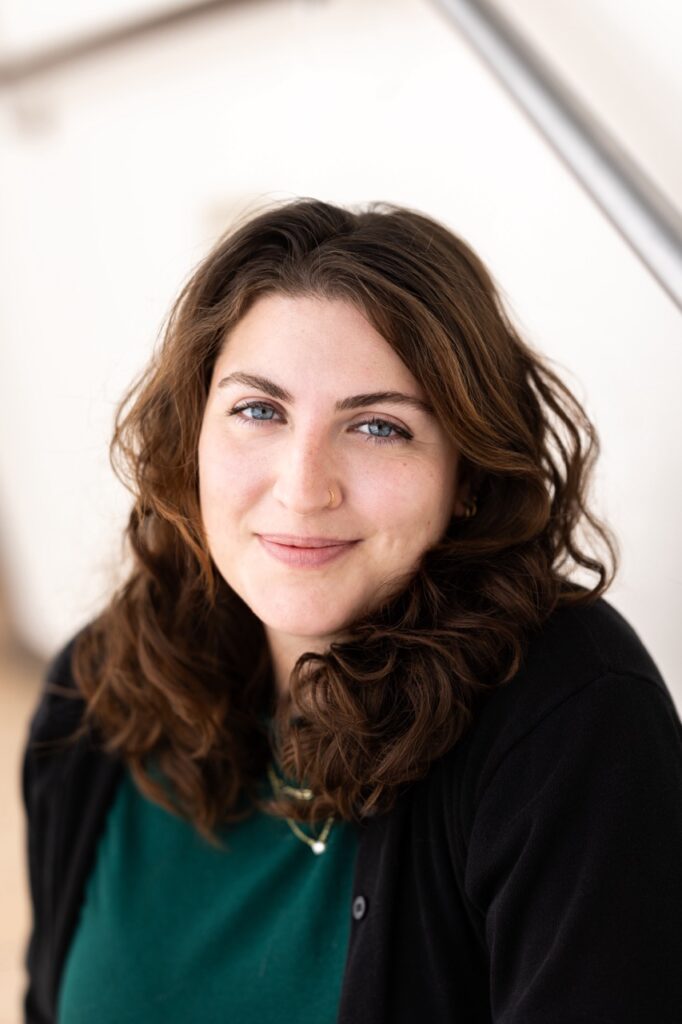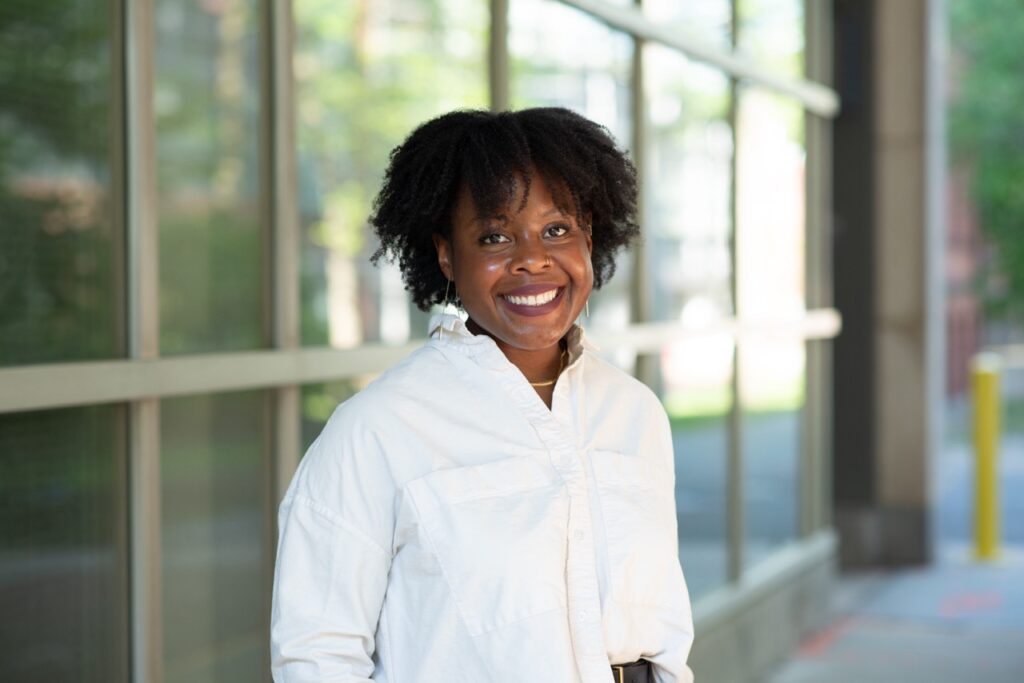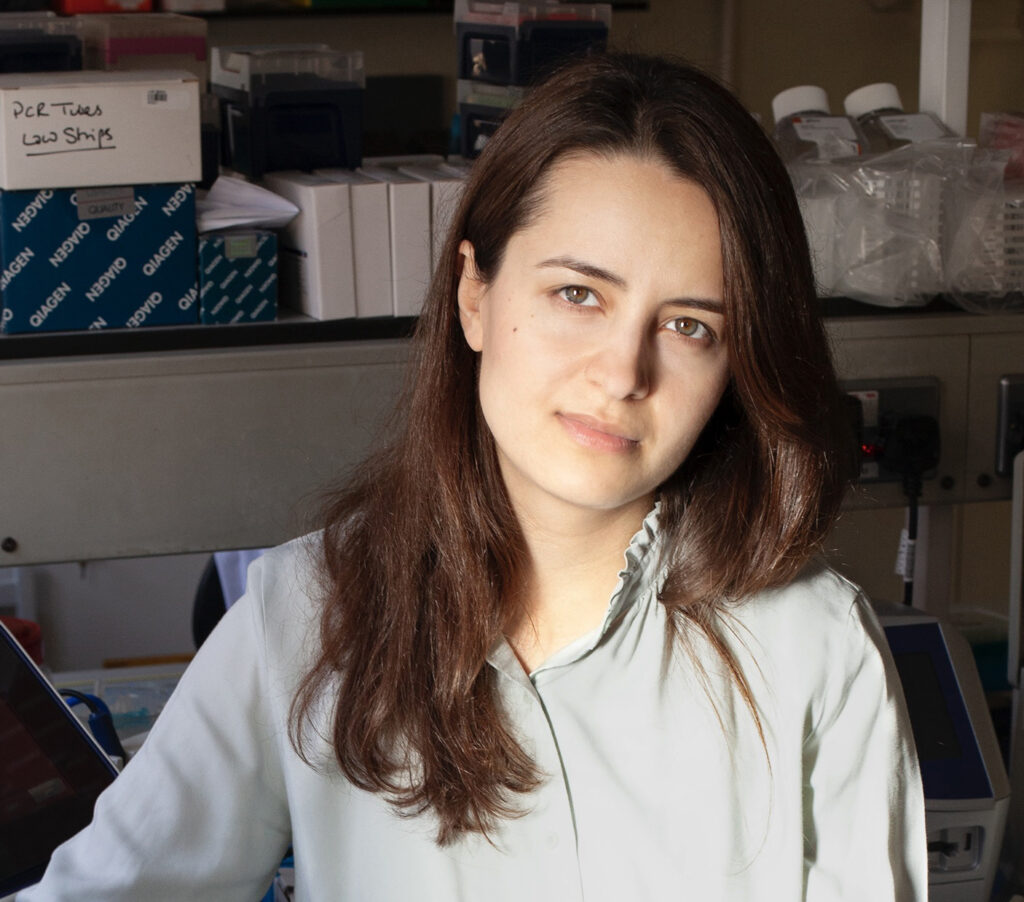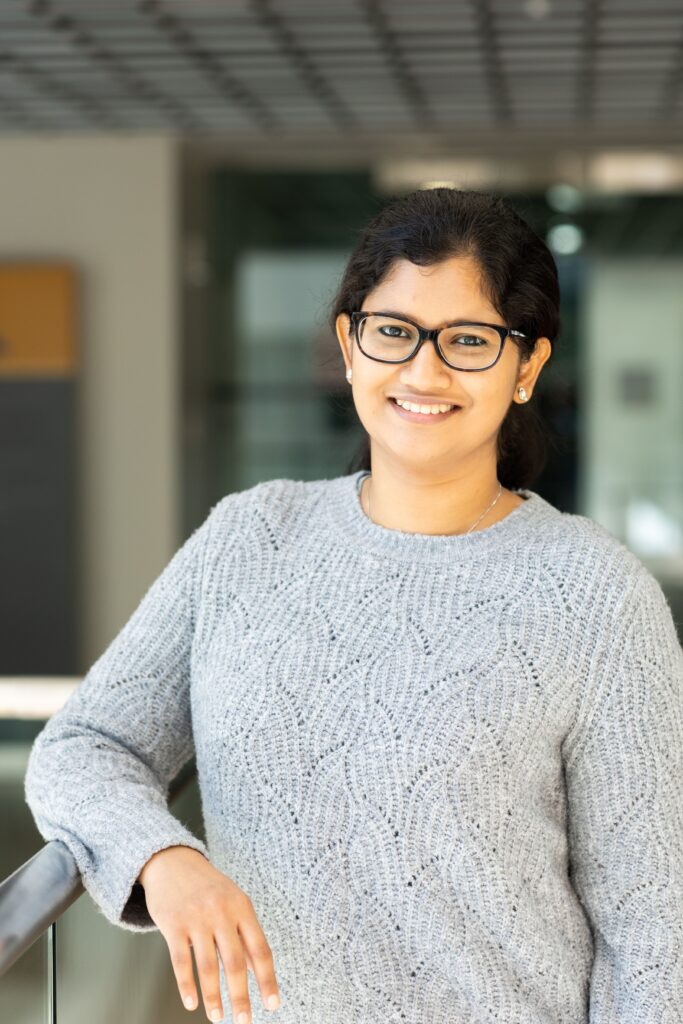Profiles
Jinyoung Kang and Margaret Schroder

Sharpening the view of molecular structures
Jinyoung Kang and Margaret Schroeder have developed a new imaging technique that could blow several research fields wide open.
Kang – a former J. Douglas Tan Postdoctoral Fellow in the labs of Ed Boyden, Y. Eva Tan Professor in Neurotechnology, and Guoping Feng, Director of the Hock E. Tan and K. Lisa Yang Center for Autism Research at MIT and James W. (1963) and Patricia T. Poitras Professor of Brain and Cognitive Sciences – and Schroeder, a recent PhD student in the Hock E. Tan and K. Lisa Yang Center for Autism Research at MIT. have been collaborating on a new way to image proteins.
“Biologists want to see really tiny structures that most microscopes can’t see,” Schroeder explains. Over the last 10 years, the Boyden lab has pioneered methods to explode these very tiny molecular structures, taking them apart so that microscope lenses can enter the now-bigger spaces closer to target structures. The team’s latest tool. called Expansion Revealing or ExR. has been adopted by labs to study a range of conditions from kidney disease to Alzheimer’s.
Kang compares the proteins to strings of yarn, each protein a small tangle of a particular color. The Boyden lab advances were akin to pulling a coin-sized tangle of yarn apart. making the space between the strands of yarn big enough to spread over a hand, for example.
The most recent advance from Kang and Schroeder combines those previous gains with new processing techniques to allow for multichannel. extremely dense images, like seeing that same coinsized tangle of yarn in a 3D model the size of a room.
“This version of the expansion [called multiExR] allows us to image up to 20 proteins in the same view,” Schroeder says. And, these technologies are ready to be implemented in labs across the world.
“This technique helps people visualize the relationship between proteins using common tools they have in their lab,” Schroeder says. To properly understand a recipe, one needs to know all the ingredients, Schroeder notes, and this new technique will allow that much more easily.
“We could combine multiple technologies like ExR. CRISPR. or proteomics to understand synapses more deeply,” Kang says. “We can expand our understanding of neurobiology and what causes disease. It can give us evidence for therapeutic targets.” If researchers can see exactly which protein is misbehaving, it will be easier to create therapies to get it back in line.
By providing scientists with clearer pictures of biological machinery, Kang and Schroeder are opening new windows into the inner workings of the body and mind. “We have great complementary expertise,” Schroder says.
Kyla Nichols

Probing the microbiome effect
Working with Katharina Ribbeck, the Andrew (1956) and Erna Viterbi Professor of Biological Engineering, Nichols aims to understand how mucins – proteins that trap germs and prevent infection – regulate hostmicrobe interactions in the gastrointestinal and female reproductive tracts.
Recent research points to evidence that an imbalance of gut bacteria may lead to Parkinson’s disease, Alzheimer’s disease, depression, and multiple sclerosis, among other conditions. Scrutinizing gut neurons for a buildup of alpha-synuclein proteins – the same ones that misfold and form clumps in the brains of Parkinson’s patients – might lead to earlier diagnoses of these diseases.
With something as simple as a cheek swab, “there’s a lot of potential to identify different biomarkers that could be indicative of a healthy microbiome,” Nichols said. “It’s possible that you could assess a person’s health through profiling unique changes in their glycans,” the primary constituents of mucins. If beneficial bacteria are lacking, there could be ways to boost them through an oral supplement or by applying them topically. “These are potential therapeutic options with minimal risks,” she said.
Studies have shown that certain mental health and gastrointestinal disorders, considered gut-brain disorders, tend to be more prevalent in women. Nichols wants to know why – and how estrogen and other sex hormones could be playing a role.
In the lab, Nichols uses mice injected with human microbiome samples to model post-traumatic stress disorder. She then gauges the connections between the animals’ stress responses and changes to their microbiomes and mucus. “We’re hoping that if we identify these specific changes, we could pinpoint a very natural type of therapeutic option that builds that mucosa I barrier back up,” she says.
Nichols is focused on how physiological changes play out in stressed female versus male mice. “I’d love to see it all come together so that I can draw a conclusion on why there might be these strong sex-based differences in mental health disorders,” she says.
Sam Merrow, Postbaccalaureate Researcher in the Feng lab

A launchpad for young scientists
Sam Merrow. a postbaccalaureate researcher in the lab of Guoping Feng -the James W. (7963) and Patricia T. Poitras Professor at MIT – showcases the best of scientific tradition: nurturing and sating curiosity in the next generation.
Merrow is part of the K. Lisa Yang Postbaccalaureate Scholar Program at MIT, which provides education, mentorship, and paid laboratory experience to enrich young scientists seeking to apply to graduate programs in neuroscience and neuroengineering.
“I still have so many questions about how things work,” Merrow says. Excitingly, Merrow will pursue their PhD studies in neuroscience at New York University starting in the fall of 2025. “The Yang Scholar Program has been a critical part of my preparation for grad school – I’ve gained a lot of technical experience and have developed my ability to be more of an independent thinker. These past two years have left me confident in pursuing my PhD,” they say.
Merrow largely credits undergraduate mentors at Simmons University for their current drive and success. “My early mentors were really invested in my success, which is why I think I was so successful.” says Merrow. “Simmons was particularly empowering for me as a non binary person in STEM,” Merrow says. “That’s when I made it my mission to operate as authentically as I can in professional spaces.”
This was a huge mental shift for Merrow. Their mother is a Brazilian immigrant who taught Merrow to keep their head down, work hard, and not draw too much attention. “The lesson was if I stand out in any way, I’m not going to succeed,” Merrow says.
Merrow is now standing out for the best reasons. In the last few months, they have garnered two awards: the Trainee Professional Development Award, presented by the Society for Neuroscience to postbaccalaureate and postdoctoral scholars who demonstrate scientific merit and excellence in research, and the Annual Biomedical Research Conference for Minoritized Scientists
(ABRCMS) travel award, presented by the American Society for Microbiology to first-time presenters at the conference.
The first award gave Merrow financial support to attend the most recent conference, where they presented a research poster at a limited session. “It was also nice to warm up a bit” before the open-to-all poster session and networking with attendees in broader study areas.
The ABRCMS award, meanwhile, is focused entirely on minoritized undergrads, postbacs, and graduate students. “I think it will be an empowering experience to meet people like me in science,” Merrow said before attending the November conference.
While Merrow prepares for the next step in their career, they envision that they’ll one day “probably be a very successful professor and Pl.” working with undergraduate students.
Zuri Sullivan, Postdoctoral Researcher in the Dulac lab at Harvard

Lighting the fire: Zuri Sullivan’s path from inspiration to impact
The immune system harbors a host of mysteries. and its relationship with the brain is murkier still. Zuri Sullivan is studying this complex topic and has turned her research into a blooming scientific career.
She’s a postdoc working in the lab of Catherine Dulac at the the Tan-Yang Center for Autism Research at Harvard University, and a Howard Hughes Medical Institute (HHMI) Hanna H. Gray Fellow investigator studying the social brain. Sullivan is exploring how the brain and myriad immune responses influence behavior, particularly during infection.
For example, why might someone want to wear their cozy socks only while congested from a sinus infection? “The most exciting thing we’ve found is that different kinds of infections generate different impacts on behavior,” she says.
Sullivan has been interested in studying the human immune system ever since attending an HHMI conference while in high school. There, she was fascinated by a talk given by Bruce Walker, an HHMI investigator, director of the Ragon Institute of Mass General Brigham, MIT. and Harvard University, and a professor at Harvard Medical School.
“And I was mind-blown I’m becoming a scientist.” she exclaims, recalling how she felt after listening to Walker’s talk about how immunology could help scientists better understand HIV and develop better vaccines. “The people in my high school were not that interested in learning in that context.” Sullivan explains. “But I was very interested.”
This experience ignited Sullivan’s passion for studying the immune system and now its interplay with the brain, which she has been rigorously probing for the past four years in Dulac’s lab.
“These little outreach moments make a difference1 If I hadn’t gone to that talk, I probably would’ve gone to medical school – which would’ve been great. but it wouldn’t have lit me up the same way,” she says.
And she’s now paying it forward. Two of her undergraduate mentees presented their work this spring at conferences and meetings. With Sullivan’s upcoming transition to heading her own lab at the Whitehead Institute next year, she’s keyed up to nurture the next generation of scientists.
“I really like getting to work with younger, budding scientists,” she says. “Even though I still think of myself as a young scientist.”
Sarthak Chandra, Postdoctoral Researcher in the Fiete lab

How math can explain mental maps
Sarthak Chandra can tell you a lot about the squishy bag of fat and electricity that is the brain. But he’ll do it using cold hard math. He is a theoretical physicist in the lab of Ila Fiete, director of the K. Lisa Yang Integrative Computational Neuroscience (ICoN) Center at MIT, and entered the field of neuroscience because he “was yearning to use mathematical tools in the real world.”
“A lot of my career so far has been going from abstract things to more-concrete things,” Chandra says. With two recent scientific papers published in Nature since the beginning of t he year, he’s doing just that. Chandra is studying grid cells, which he describes as “the CPS of the brain” that helps people and animals figure out where they are in space.
In the first paper, published in Nature in February 2025, he and his research team developed a new mathematical model that helps explain how grid cells form in the brain. These cells occur in distinct categories or modules, a pattern known as modularity. By integrating different biological features into their model. it churned out mathematical evidence for how modularity arises in grid cells.
Chandra asked another interesting question: Where else in nature can we see modularity? As it turns out. Chandra and his coauthors found that their model could also explain discrete ecological niches, the slot an organism fills in its ecosystem: apex predator, grass-eating herd, etc. “To apply a rule that matches a biological system so perfectly, it was an incredible experience,” Chandra says.
Chandra’s other paper, published in Nature in January 2025, focuses more on grid-cell function. “Our first paper focused on the ‘how· of grid cells. This paper focuses more on the ‘why’ of them,” he says. The team found that the grid-cell modules were strongly linked to the brain’s hippocampus, the center of episodic memory and spatial navigation.
Storing memories in a “virtual place” that one can visit in their mind and recall that information much more easily and reliably is a concept also known as a “mind palace,” Chandra explains. Most memory models hit a “memory cliff’- beyond a certain number of “memories,” the model collapses and forgets everything. But when Chandra and his team developed a model linked to a scaffold of spatial representations, “we get much more realistic slow decay – this model that more closely mirrors reality,” he says.
“Towards the end of my PhD, I wanted to switch away from [the] purely theoretical. and neuroscience seemed like an interesting area where my theoretical skills could be useful.” Chandra adds. “Ila [Fiete] took a chance on me: she also has a background in physics. Since then, I’ve been looking at physics approaches in neuroscience.”
Nagina Mangal, 2023-2025 K. Lisa Yang and Hock E. Tan Center for Molecular Therapeutics

Probing the biology of brain circuitry
For as long as she can remember, Nagina Mangal has loved science. Now she is channeling her skills as a molecular and cellular biologist to understand brain circuitry and, hopefully, open doors to improved therapies for neurologic and neuropsychiatric disorders.
Mangal, a Y. Eva Tan Postdoctoral Fellow, is conducting research in the laboratory of Ann Graybiel, an institute professor at MIT. Mangal and her colleagues are studying the striatal region of the forebrain, which is essential for motor control, emotions, and other behaviors. When dysfunctional, this large region is associated with such disorders as Parkinson’s and Huntington’s disease, autism spectrum disorder, addiction, impulsivity, and depression. The neurotransmitter dopamine plays an important role in these neural circuits.
“We’re trying to work out the circuitry in the striatum, because knowing the fundamental biology leads to therapeutics,” she says.
Mangal is building on her earlier research on the endocannabinoid system, an endogenous signaling system important for regulating learning, memory, mood, sleep, appetite, and other critical bodily functions. For one of her postdoc projects, she’s investigating the role of CB1 receptors — the most highly expressed GPCR (G protein–coupled receptor) — in the brain.
Graybiel’s lab previously discovered that when the CB1 receptor is knocked out in mice, a cell structure that resembles a bouquet of flowers, topped by dopamine “petals,” withers at its stem-like section. Mangal says they’re eager to know, “Why are these bouquet structures withering when CB1 is knocked out?”
“I hope my research will answer the questions: Is CB1 important in the brain? Is it changing dopamine circuitry? How can we take the basic biology that we know from in vivo studies and translate that to therapies for Parkinson’s and other disorders?”
Starting from scratch
Early in her life, Mangal moved from Afghanistan to London; she spoke barely any English, but there were more opportunities for 6-year-old Mangal and her sister. “We had nothing. We started from scratch, and I worked my way up,” she recalls. “I found that the more science I learned, the less I knew — and this got me hooked.”
She earned a bachelor’s degree in biochemistry from the University of London, a master’s of research in stem cells and developmental biology from the University College London, and a PhD in clinical medicine research from Imperial College London in 2023. Her doctorate highlighted the effects of the endocannabinoid system on pancreatic cancer.
Mangal’s research interests led her to a journal paper of Graybiel’s on the CB1 receptor in the striatum, eventually joining Graybiel’s team for her postdoctoral training with critical support from the Y. Eva Tan Postdoctoral Fellowship.
“I am thrilled that this fellowship exists and delighted to be part of the Yang Tan Collective community,” Mangal says. “I’m very grateful to Ms. Yang and Mr. Tan for their immense support.”
Sreeparna Pradhan, 2022-2024 K. Lisa Yang Brain-Body Fellow

Investigating gut-brain communication
Anyone who has felt “butterflies in the stomach” from being excited or anxious knows there’s a palpable link between our digestive system and brain. But exactly how these two parts of the body’s nervous system “talk” to each other isn’t fully clear.
Sreeparna Pradhan, a postdoctoral fellow in the K. Lisa Yang Brain-Body Center, is providing more clarity by studying the role of neuropeptides in gut-brain communication in Caenorhabditis elegans, a transparent worm used as a model organism in research. She’s doing so in the lab of Steven Flavell, an associate professor of brain and cognitive sciences.
Understanding this two-way interplay opens the door to potential therapies for conditions with gastrointestinal symptoms, from autism spectrum disorder to Parkinson’s disease to depression and anxiety.
Neuropeptides are small proteins that help neurons communicate. Although neurons typically connect through synapses when they are close together, they can also “talk” from farther away by releasing peptides that act as neurotransmitters, or chemical messengers, Pradhan explains. Scientists have mapped all 302 neurons and thousands of synapses in C. elegans, but its network of neuropeptides is less well-known.
Pradhan’s current research examines how microorganisms in the digestive system affect the brain. This entails feeding the worms pathogenic bacteria, tracking the animals’ behavior as they become ill — including eating less and slowing down — and using genetically engineered strains to locate the signals coordinating communication between gut and brain. The team has identified a number of neuropeptides involved in this process; Pradhan is investigating which neurons are releasing them, as well as changes in the worms’ brain activity.
“I am very excited about this project,” she says. “It contributes to our understanding of the mechanisms by which gut bacterial infections can influence the brain and behavior. We found that neuropeptide systems can be integral to this cross talk.”
Thinking big
Raised in Kolkata, India, Pradhan earned bachelor’s and master’s degrees in biotechnology and pursued her PhD in neuroscience at McGill University, in Montreal. There, she studied how stressful early experiences like starvation can have long-lasting effects.
At McGill, Pradhan imaged individual C. elegans neurons but wanted a bigger-picture understanding of brain-body communication and its impact on disease and health. The Flavell lab, which she joined in November 2020, was an ideal destination because it has developed technology to image the whole nervous system of freely moving C. elegans using a video tracker and machine learning tools.
How can this nematode inform human health? Many of the genetic pathways in both C. elegans and humans have been “conserved” through evolution and uphold the same principles of communication. “Studying simple invertebrate systems,” Pradhan points out, “has yielded foundational discoveries in many areas of biology.”
Pradhan is deeply grateful for the inaugural K. Lisa Yang Brain-Body Postdoctoral Fellowship, especially as an international scientist. Her future plans include investigating bacterial communication in the intestine and neuropeptides’ role in regulating sleep in animals. “I plan on becoming a tenure-track professor and pursuing some of these ideas in my own lab,” she says.
Maedbh King, 2022-2025 K. Lisa Yang Integrative Computational Neuroscience (ICoN) Center Fellow

Refining mental health diagnoses
Maedbh King came to MIT to make a difference in mental health. As a postdoctoral fellow in the K. Lisa Yang Integrative Computational Neuroscience (ICoN) Center, she is building computer models aimed at helping clinicians improve diagnosis and treatment, especially for young people with neurodevelopmental and psychiatric disorders.
Tapping two large patient-data sources, King is working to analyze critical biological and behavioral information to better categorize patients’ mental health conditions, including autism spectrum disorder, attention-deficit hyperactivity disorder (ADHD), anxiety, and suicidal thoughts — and to provide more predictive approaches to addressing them. Her strategy reflects the center’s commitment to a holistic understanding of human brain function using theoretical and computa-tional neuroscience.
“Today, treatment decisions for psychiatric disorders are derived entirely from symptoms, which leaves clinicians and patients trying one treatment and, if it doesn’t work, trying another,” says King. “I hope to help change that.”
King grew up in Dublin, Ireland, and studied psychology in college; gained neuroimaging and programming skills while earning a master’s degree from Western University in Canada; and received her doctorate from the University of California, Berkeley, where she built maps and models of the human brain. In fall 2022, King joined the lab of Satrajit Ghosh, a McGovern Institute principal research scientist whose team uses neuroimaging, speech communication, and machine learning to improve assessments and treatments for mental health and neurological disorders.
Big-data insights
King is pursuing several projects using the Healthy Brain Network, a landmark mental health study of children and adolescents in New York City. She and lab colleagues are extracting data from cognitive and other assessments — such as language patterns, favorite school subjects, and family mental illness history — from roughly 4,000 participants to provide more-nuanced understanding of their neurodevelopmental disorders, such as autism or ADHD.
“Computational models are powerful. They can identify patterns that can’t be obtained with the human eye through electronic records,” says King.
With this database, one can develop “very rich clinical profiles of these young people,” including their challenges and adaptive strengths, King explains. “We’re interested in placing these participants within a spectrum of symptoms, rather than just providing a binary label of, ‘has this disorder’ or ‘doesn’t have it.’ It’s an effort to subtype based on these phenotypic assessments.”
In other research, King is developing tools to detect risk factors for suicide among adolescents. Working with psychiatrists at Children’s Hospital of Philadelphia, she is using detailed questionnaires from some 20,000 youths who visited the hospital’s emergency department over several years; about one-tenth had tried to take their own lives. The questionnaires collect information about demographics, lifestyle, relationships, and other aspects of patients’ lives.
“One of the big questions the physicians want to answer is, Are there any risk predictors we can identify that can ultimately prevent, or at least mitigate, future suicide attempts?” King says. “Computational models are powerful. They can identify patterns that can’t be obtained with the human eye through electronic records.”
King is passionate about producing findings to help practitioners, whether they’re clinicians, teachers, parents, or policy makers, and the populations they’re studying. “This applied work,” she says, “should be communicated in a way that can be useful.
